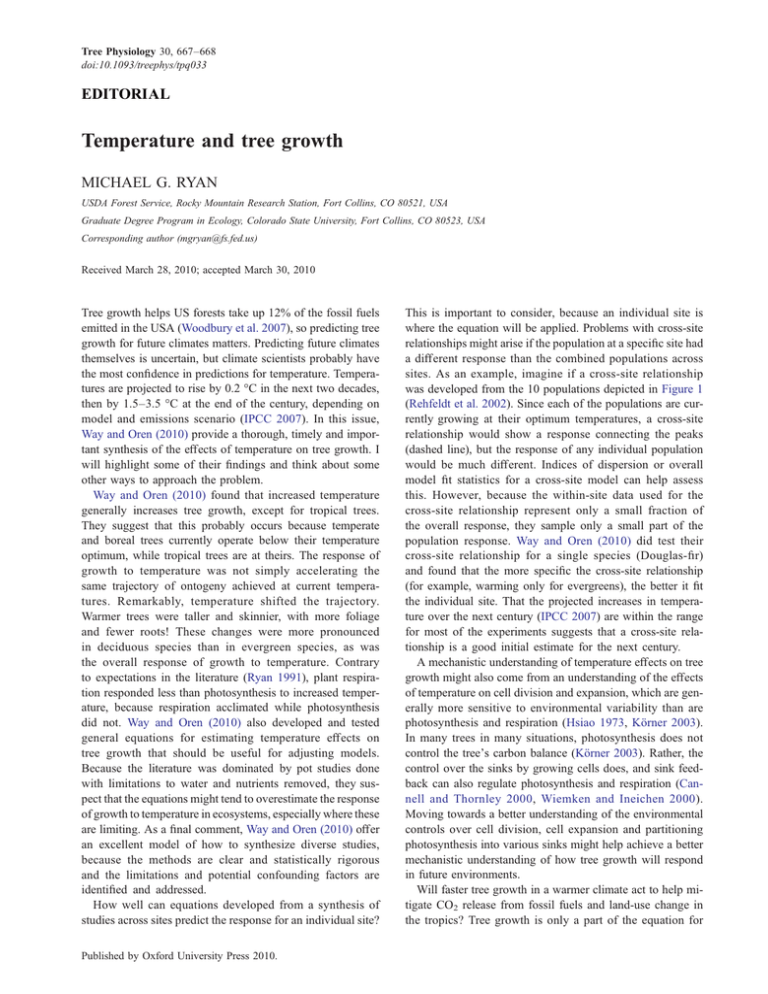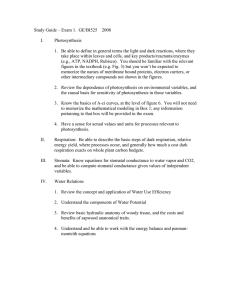Temperature and tree growth EDITORIAL MICHAEL G. RYAN
advertisement

Tree Physiology 30, 667–668 doi:10.1093/treephys/tpq033 EDITORIAL Temperature and tree growth MICHAEL G. RYAN USDA Forest Service, Rocky Mountain Research Station, Fort Collins, CO 80521, USA Graduate Degree Program in Ecology, Colorado State University, Fort Collins, CO 80523, USA Corresponding author (mgryan@fs.fed.us) Received March 28, 2010; accepted March 30, 2010 Tree growth helps US forests take up 12% of the fossil fuels emitted in the USA (Woodbury et al. 2007), so predicting tree growth for future climates matters. Predicting future climates themselves is uncertain, but climate scientists probably have the most confidence in predictions for temperature. Temperatures are projected to rise by 0.2 °C in the next two decades, then by 1.5–3.5 °C at the end of the century, depending on model and emissions scenario (IPCC 2007). In this issue, Way and Oren (2010) provide a thorough, timely and important synthesis of the effects of temperature on tree growth. I will highlight some of their findings and think about some other ways to approach the problem. Way and Oren (2010) found that increased temperature generally increases tree growth, except for tropical trees. They suggest that this probably occurs because temperate and boreal trees currently operate below their temperature optimum, while tropical trees are at theirs. The response of growth to temperature was not simply accelerating the same trajectory of ontogeny achieved at current temperatures. Remarkably, temperature shifted the trajectory. Warmer trees were taller and skinnier, with more foliage and fewer roots! These changes were more pronounced in deciduous species than in evergreen species, as was the overall response of growth to temperature. Contrary to expectations in the literature (Ryan 1991), plant respiration responded less than photosynthesis to increased temperature, because respiration acclimated while photosynthesis did not. Way and Oren (2010) also developed and tested general equations for estimating temperature effects on tree growth that should be useful for adjusting models. Because the literature was dominated by pot studies done with limitations to water and nutrients removed, they suspect that the equations might tend to overestimate the response of growth to temperature in ecosystems, especially where these are limiting. As a final comment, Way and Oren (2010) offer an excellent model of how to synthesize diverse studies, because the methods are clear and statistically rigorous and the limitations and potential confounding factors are identified and addressed. How well can equations developed from a synthesis of studies across sites predict the response for an individual site? Published by Oxford University Press 2010. This is important to consider, because an individual site is where the equation will be applied. Problems with cross-site relationships might arise if the population at a specific site had a different response than the combined populations across sites. As an example, imagine if a cross-site relationship was developed from the 10 populations depicted in Figure 1 (Rehfeldt et al. 2002). Since each of the populations are currently growing at their optimum temperatures, a cross-site relationship would show a response connecting the peaks (dashed line), but the response of any individual population would be much different. Indices of dispersion or overall model fit statistics for a cross-site model can help assess this. However, because the within-site data used for the cross-site relationship represent only a small fraction of the overall response, they sample only a small part of the population response. Way and Oren (2010) did test their cross-site relationship for a single species (Douglas-fir) and found that the more specific the cross-site relationship (for example, warming only for evergreens), the better it fit the individual site. That the projected increases in temperature over the next century (IPCC 2007) are within the range for most of the experiments suggests that a cross-site relationship is a good initial estimate for the next century. A mechanistic understanding of temperature effects on tree growth might also come from an understanding of the effects of temperature on cell division and expansion, which are generally more sensitive to environmental variability than are photosynthesis and respiration (Hsiao 1973, Körner 2003). In many trees in many situations, photosynthesis does not control the tree’s carbon balance (Körner 2003). Rather, the control over the sinks by growing cells does, and sink feedback can also regulate photosynthesis and respiration (Cannell and Thornley 2000, Wiemken and Ineichen 2000). Moving towards a better understanding of the environmental controls over cell division, cell expansion and partitioning photosynthesis into various sinks might help achieve a better mechanistic understanding of how tree growth will respond in future environments. Will faster tree growth in a warmer climate act to help mitigate CO2 release from fossil fuels and land-use change in the tropics? Tree growth is only a part of the equation for 668 RYAN 13 Year height (cm) 600 References 400 200 0 500 1000 1500 2000 2500 3000 Degree-days > 5 °C Figure 1. The response of tree growth to temperature differs among populations, where each population is found at the peak of its growth curve (black circles). A cross-site relationship for this data (dashed line) would poorly predict the response of any given population. carbon stored in forests or available for use as low carbon biomass fuels or for substitution for concrete and steel (material with high carbon costs for manufacture). The other part of the equation, the response of rates of tree mortality to future climate, is unknown (Ryan et al. 2010). Disturbances such as forest fires, insect outbreaks and storms may increase in a warmer world (Ryan et al. 2008), and there are some suggestions that those increases may be occurring now (Westerling et al. 2006). If disturbances do increase, any increase in forest carbon storage or availability from faster growth could be negated by disturbance losses unless tree mortality can be used quickly after it occurs. Cannell, M.G.R. and J.H.M. Thornley. 2000. Modelling the components of plant respiration: some guiding principles. Ann. Bot. 85:45–54. Hsiao, T.C. 1973. Plant responses to water stress. Annu. Rev. Plant Physiol. Plant Mol. Biol. 24:519–570. IPCC. 2007. Climate Change 2007: Synthesis Report. Contribution of Working Groups I, II and III to the Fourth Assessment Report of the Intergovernmental Panel on Climate Change. Eds. R.K. Pachauri and A. Reisinger. IPCC, Geneva, p 104. Körner, C. 2003. Carbon limitation in trees. J. Ecol. 91:4–17. Rehfeldt, G.E., N.M. Tchebakova, Y.I. Parfenova, W.R. Wykoff, N.A. Kuzmina and L.I. Milyutin. 2002. Intraspecific responses to climate in Pinus sylvestris. Global Change Biol. 8:912–929. Ryan, M.G. 1991. The effect of climate change on plant respiration. Ecol. Appl. 1:157–167. Ryan, M.G., S.R. Archer, R.A. Birdsey et al. 2008. Land resources. In The Effects of Climate Change on Agriculture, Land Resources, Water Resources, and Biodiversity, SAP 4-3. Eds. T. Janetos, D. Schimel and P. Backland. US Climate Change Science Program, Washington, DC, p 123–182. Ryan, M.G., M.E. Harmon, R.A. Birdsey et al. 2010. A Synthesis of the Science on Forests and Carbon for U.S. Forests. Issues in Ecology. Vol. 13. Ecological Society of America, Washington, DC, p 1–16. Way, D.A. and R. Oren. 2010. Differential responses to changes in growth temperature between trees from different functional groups and biomes: a review and synthesis of data. Tree Physiol. 30:669–688. Westerling, A.L., H.G. Hidalgo, D.R. Cayan and T.W. Swetnam. 2006. Warming and earlier spring increase western US forest wildfire activity. Science 313:940–943. Wiemken, V. and K. Ineichen. 2000. Seasonal fluctuations of the levels of soluble carbohydrates in spruce needles exposed to elevated CO2 and nitrogen fertilization and glucose as a potential mediator of acclimation to elevated CO2. J. Plant Physiol. 156: 746–750. Woodbury, P.B., J.E. Smith and L.S. Heath. 2007. Carbon sequestration in the US forest sector from 1990 to 2010. For. Ecol. Manage. 241:14–27. TREE PHYSIOLOGY VOLUME 30, 2010






